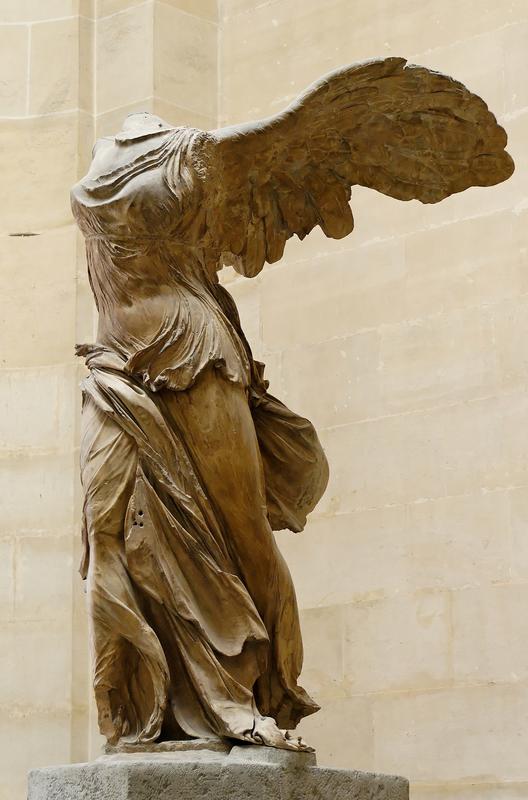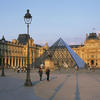More about Winged Victory of Samothrace

Sr. Contributor
The resurrection of the Winged Victory of Samothrace is a series of victories in itself.
The statue remains incomplete, but it’s come an amazingly long way since its discovery. This marble goddess was unearthed in 110 pieces on the Greek island of Samothrace in 1863 by Charles Champoiseau, sans any trace of the head or arms. He returned sixteen years later to find them and, while he had no luck with the body parts, he did return with pieces of the ship that forms her mount.
Once all the fragments were reassembled there was a lot more missing than just her head and arms. Luckily, enough remained for them to piece together the identity of our goddess. Specifically, small bits of feathers gave her away as Nike, the goddess of victory. There were enough pieces of the left wing to secure it back together with a metal frame to keep its structure. There was little of the right wing, so it was mirror cast out of the left wing in plaster. The restoration work is done so carefully and seamlessly you wouldn’t guess how much of the statue was remade in plaster. Not just a wing, but also the left side of the torso and the belt. As there were no pieces or model for the head, arms, and feet, those weren’t remade, but the statue remains striking regardless. The staircase the Louvre currently houses it in couldn’t be more fitting as it echoes the grandeur of its original home.
What makes our Nike so notable among Greek statues of the Hellenistic periods is that it held a place of honor in the temple of Samothrace, likely being a gift in reference to a naval victory. Winged Victory and the island of Samothrace both can boast of a rich history, but sadly are shrouded in mystery because mystery cults liked keeping true to their name. If you’re unfamiliar with mystery cults, in short, they were secretive groups of worshippers in Ancient Greece who focused their devotion on a particular god of the Greek pantheon. All of the rituals, guidelines, etc., were only known by members of the cult. Participation in these cults usually came with the promise of certain rewards from said god, like an honored place in the afterlife.
In The Argonautica, Samothrace gets a very brief mention. Orpheus, being the son of Apollo, the god of seafaring, suggests that the argonauts get initiated into one of these cult for protection at sea. But Apollonius of Rhodes writes “Of the rites I say no more, pausing only to salute the isle itself and the Powers that dwell in it, to whom belong the mysteries of which we must not sing.” Luckily for us, there were other writers willing to sing a bit and spill the tea in fragments that survived the centuries. Unfortunately, it wasn't much. To sum up our actual understanding of Samothrace’s history I’d wager it's the equivalent of a blurry movie trailer. Researchers aren’t even certain who the gods worshipped on Samothrace were.
The temple at Samothrace was unique among mystery cults because they weren’t restrictive about membership. It didn’t matter what your gender was, how wealthy you were, or even if you were a slave, you could become an initiate. Most other cults also had restrictions on the day or season you could be inducted, but with Samothrace there could be a ceremony any night. The reward for initiation was being able to invoke the protection of the gods for safe voyage over the sea.
Jason and the Argonauts weren’t the only mythical visitors the cult can boast of, it’s said Odysseus’s life was saved by the protection he gained there. Initiates often liked to give gifts and offerings to the temple in thanks. As for the initiates who gifted Winged Victory, sadly there are no solid theories, real or mythical. We do know that the temple honored the statue over their countless other offerings by showcasing it at the tallest point in the complex, above the theater.
The newly initiated would be able to admire the statue in the light of dawn, but that was only after they made it through the ritual where they were likely blindfolded. If you ever get your hands on a time machine and want to go see the statue back in its completely intact glory days, here’s our best guess as to what you’re in for:
The ceremony won’t take place until dusk but the head priest might have conducted the preliminaries prior to sunset. You’d likely get faced with a proclamation about the absence of bloodshed. They’d basically outlined that if you have any outstanding murders you’ve yet to get purified for please get lost and come back later. After that, you'd undergo purification rites, like cleansing in the stream that runs by the temple.
Then, night falls and the first stage called mystai begins. There’s some evidence you’d have been blindfolded, then led down a series of steps into the valley where the main temple structures were. You might have passed the Theatrical Circle, a round floor of roughly nine feet surrounded by five tiers of bronze statues dedicated by past initiates. There might have been chanting with music from tambourines and other instruments while ritual dancers whirled around you. Then of course, animal sacrifices and libations of wine for the gods.
If you got through all that you’d be given a fancy purple sash and a magnetic iron ring. If you’re still feeling like you weren’t pious enough to sail, you’d have volunteered for the next stage, epoptia. No blindfold for this stage. We know from an inscription on the Hieron, one of the largest buildings in the complex, you couldn’t enter without having completed stage one so this is likely where stage two happened. The vague descriptions we have hint at an added level of difficulty, referring to something about confessions of sins and absolution.
You’d also be subjected to something called the “sacred tale." Don’t take the name too seriously though, most of what we know about the content is scandalous details like a Letters to Penthouse you had to be sworn to secrecy to hear. You’d have gotten to learn a myth about Hermes’ erection and probably why all his traveler statues feature it so prominently. Said myth likely featured a naked Persephone and talk of sexual arousal. There would have a grand finale of some sort of sacred light and then you’d get to spend the rest of the night feasting in celebration to your newfound piety.
The only thing I’m really sure of is that the highlight of it all would be going to see Winged Victory on its perch at sunrise. Maybe in a few more centuries we’ll find the rest and get to see it in its full glory ourselves, without any cult rituals.
Sources
- “A Stairway to Victory.” Le Louvre. Accessed November 17, 2021. https://www.louvre.fr/en/ explore/the-palace/a-stairway-to-victory.
- Apollonius of Rhodes. Argonautica. the Voyage of Argo. Penguin Books, 1959.
- Bremmer, Jan N. Initiation into the Mysteries of the Ancient World. De Gruyter, 2014.
- Cole, Susan Guettel. Theoi Megaloi: The Cult of the Great Gods at Samothrace. Leiden: E.J. Brill, 1984.
- Dimitrova, Nora Mitkova. Theoroi and Initiates in Samothrace: The Epigraphical Evidence. Princeton, N.J: The American School of Classical Studies at Athens, 2008.
- Meijer, Cindy, and Branko van Oppen. “Winged Victory - the Nike of Samothrace.” Ancient World Magazine. Accessed November 17, 2021. https://www.ancientworldmagazine .com/articles/winged-victory-nike-samothrace/.
- Wescoat, Bonna. “Explore the Temples of an Ancient Greek Cult.” Magazine. National Geographic, May 4, 2021. https://www.nationalgeographic.com/magazine/article/ samothrace-greek-cult-initiate-video.
- “Winged Victory of Samothrace.” A closer look at the Victory of Samothrace | Musée du Louvre. Accessed November 17, 2021. http://musee.louvre.fr/oal/victoiredesamothrace/ victoiredesamothrace_acc_en.html.
Featured Content
Here is what Wikipedia says about Winged Victory of Samothrace
The Winged Victory of Samothrace, or the Niké of Samothrace, is a votive monument originally discovered on the island of Samothrace in the northeastern Aegean Sea. It is a masterpiece of Greek sculpture from the Hellenistic era, dating from the beginning of the 2nd century BC (190 BC). It is composed of a statue representing the goddess Nike (Victory), whose head and arms are missing, and a base in the shape of a ship's bow.
The total height of the monument is 5.57 metres (18 ft 3 in) including the socle; the statue alone measures 2.75 metres (9 ft 0 in). The sculpture is one of a small number of major Hellenistic statues surviving in the original, rather than Roman copies.
Winged Victory has been exhibited at the Louvre in Paris, at the top of the main staircase, since 1884. Greece is seeking the return of the sculpture.
Check out the full Wikipedia article about Winged Victory of Samothrace












